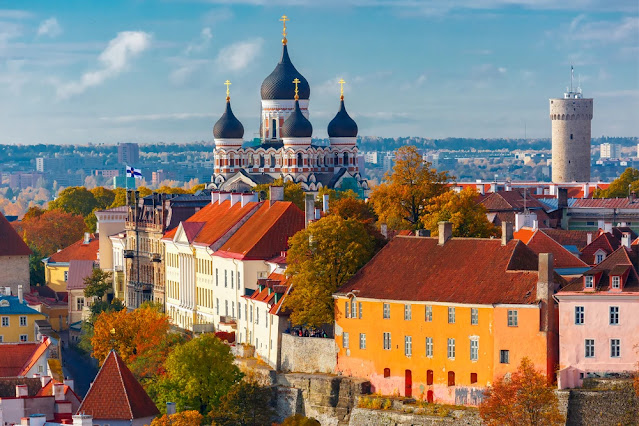Tallinn, the capital of Estonia, is truly one of the gems of Northern Europe. The city lies on the southern coast of the Gulf of Finland, only 70 km (43 mi) south of Helsinki. At the historical heart of the city is the hill of Toompea, covered in cobbled streets and filled with medieval houses and alleyways. The lower town spreads out from the foot of the hill, still protected by the remnants of a city wall. Around the city wall is a series of well-maintained green parks, great for strolling.
Estonia's history is sprinkled liberally with long stretches of foreign domination, beginning in 1219 with the Danes, followed without interruption by the Germans, Swedes, and Russians. Only after World War I, with Russia in revolutionary wreckage, was Estonia able to declare its independence. Shortly before World War II, in 1940, that independence was usurped by the Soviets, who—save for a brief three-year occupation by Hitler's Nazis—proceeded to suppress all forms of national Estonian pride for the next 50 years. Estonia finally regained independence in 1991. In the early 1990s, Estonia's own Riigikogu (Parliament), not some other nation's puppet ruler, handed down from the Upper City reforms that forced Estonia to blaze its post-Soviet trail to the European Union. Estonia has been a member of the EU since 2004, and in 2011, the country and its growing economy joined the Eurozone. Tallinn was also named the European City of Culture in 2011, cementing its growing reputation as a cultural hot spot.
Estonia's history is sprinkled liberally with long stretches of foreign domination, beginning in 1219 with the Danes, followed without interruption by the Germans, Swedes, and Russians. Only after World War I, with Russia in revolutionary wreckage, was Estonia able to declare its independence. Shortly before World War II, in 1940, that independence was usurped by the Soviets, who—save for a brief three-year occupation by Hitler's Nazis—proceeded to suppress all forms of national Estonian pride for the next 50 years. Estonia finally regained independence in 1991. In the early 1990s, Estonia's own Riigikogu (Parliament), not some other nation's puppet ruler, handed down from the Upper City reforms that forced Estonia to blaze its post-Soviet trail to the European Union. Estonia has been a member of the EU since 2004, and in 2011, the country and its growing economy joined the Eurozone. Tallinn was also named the European City of Culture in 2011, cementing its growing reputation as a cultural hot spot.
MY EXCURSION: HOP-ON-HOP-OFF
This town is small so I walked around on my own and did some shopping and then took a hop-on-hop-off tour.
After a late lunch I headed back to the ship. After dinner I went to the "Take Five" jazz club and had a few drinks with my Quebec friends, then off to bed for an early night.










Really great pictures of you 💗
ReplyDeleteThanks hon!
DeleteI love the ancient structures. And you fit in the pictures perfectly with your beautiful smile
ReplyDeleteSo sweet of you to say! Thanks!
ReplyDelete